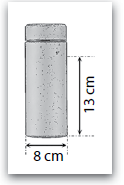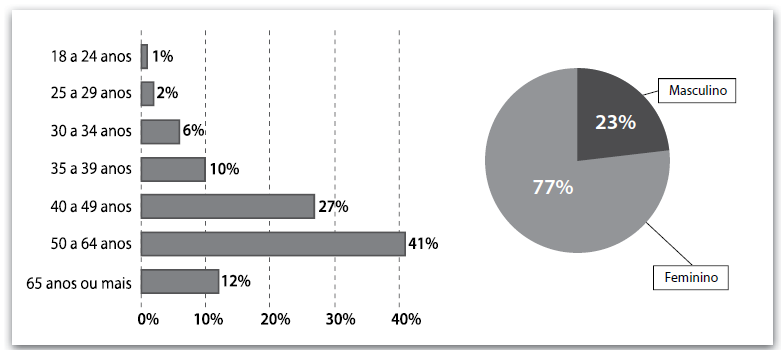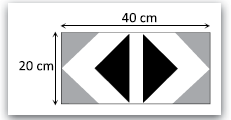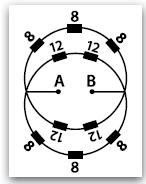Questões de Vestibular FATEC 2018 para Vestibular, Primeiro Semestre
Foram encontradas 54 questões
Entre os gráficos 1, 2 e 3, aquele que representa corretamente a reação da fosfina com o oxigênio, descrita no texto, é o
A equação química balanceada que representa a reação de neutralização total que ocorre entre essas substâncias é
2 PH3 (g) + 4 O2 (g) → P2O5 (g) + 3 H2O (g)
As substâncias que atuam como agente oxidante e agente redutor desse processo são, respectivamente,
NH3 (g) + H2O (l) ⇌ NH4+ (aq) + OH– (aq)
Uma solução aquosa de NH3 apresenta concentração inicial de 0,02 mol/L a 25oC. Nessas condições, o valor da concentração de íons OH– , em mol/L, é
Dado: Constante de basicidade da amônia a 25o C: Kb = 1,8 × 10-5
A = (10 12 8) e B =
 , em que:
, em que: • a matriz A representa o valor, em reais, recebido por hora trabalhada de João, Sílvia e Pedro, respectivamente; • a matriz B representa a quantidade de horas trabalhadas por semana dos mesmos funcionários, em cada uma das quatro primeiras semanas no mês de julho de 2018; • na matriz B, as linhas 1 a 3 são para João, Sílvia e Pedro, respectivamente; e as colunas de 1 a 4 são, nessa ordem, para as quatro primeiras semanas do mês de julho, de modo que, por exemplo, o elemento b13 é a quantidade de horas que João trabalhou na terceira semana desse mês.
O valor pago pela empresa pelas horas trabalhadas por esses três funcionários na segunda semana de julho de 2018 será
O suco é despejado num copo vazio, também de formato cilíndrico e base plana, cujo diâmetro da base é 4 cm e com altura de 7 cm. O copo fica totalmente cheio de suco, sem desperdício.

Nessas condições, o volume de suco restante na garrafa é, em cm³, aproximadamente,
Adote π = 3. Despreze a espessura do material da garrafa e do copo.
Considere que:
• a frequência cardíaca máxima de uma pessoa, em batimentos por minuto (bpm), é a diferença entre uma constante K e a idade da pessoa. O valor de K para um homem é 220 e, para uma mulher, K é 226.
• a frequência cardíaca ideal para queimar gordura e emagrecer durante um treino é de 60% a 75% da frequência cardíaca máxima.
Dessa forma, a frequência cardíaca ideal para queimar gordura e emagrecer durante um treino para um homem
de 40 anos, em bpm, varia de

Fonte de dados:<https://tinyurl.com/ycgl2ljx> Acesso em: 09/10/2018. Adaptado.
Suponha que uma viagem será sorteada entre todos os artesãos brasileiros, a probabilidade de que o ganhador da viagem seja uma mulher de 65 anos ou mais é de

Cada triângulo preto é retângulo e isósceles com hipotenusa 12 √2 cm. Cada triângulo cinza é semelhante a um triângulo preto e possui dois lados de medida 10 cm. Assim posto, a área no padrão bordada em branco é, em cm² ,
Para o exercício, considere situação ideal e g = 10 m/s²
Desconsiderando as acelerações de saída e de
chegada do navio nos portos de Brevik e Larvik, é correto
afirmar que
Para o exercício, considere situação ideal e g = 10 m/s²
Se o navio, considerado estável, percorre um trecho
qualquer em velocidade de cruzeiro, podemos concluir
que a quantidade de movimento, em kg· m/s, nesse
trecho especificado é, aproximadamente,
Para o exercício, considere situação ideal e g = 10 m/s²
Relacionando as informações do texto com os respectivos conceitos físicos, está correto afirmar que
Para o exercício, considere situação ideal e g = 10 m/s²
A figura apresenta a obra de litogravura “Mão com esfera refletora” (1935), do artista gráfrico holandês Maurits Cornelis Escher (1898–1972), que se representou por uma imagem refletida em uma esfera.

<https://tinyurl.com/yardzola> Acesso em: 15.10.2018.
Sendo o artista o objeto refletido na superfície dessa
esfera, podemos afirmar corretamente, sobre essa imagem
formada, que se
Para o exercício, considere situação ideal e g = 10 m/s²
Um circuito eletrônico utilizado pelos alunos da FATEC possui resistores, medidos em ohm, e uma ddp de 12 V entre os pontos A–B , conforme a figura.

O valor da corrente elétrica da associação de resistores
no circuito apresentado na figura, em ampère, é
Leia o texto.
“Há 8 mil anos, o espaço geográfico onde se localiza o Brasil possuía 9,8% das florestas mundiais. Nesse mesmo período, a Europa, sem a Rússia, possuia cerca de 7%; a África quase 11%; e a Ásia, 23,6%.
No início do século XXI, o espaço geográfico onde se localiza o Brasil detinha 28,3% das florestas mundiais. A Europa, sem a Rússia, detinha apenas 0,1%; a África estava com 3,4%; e a Ásia, 5,5%.
Fonte dos dados: MIRANDA, Evaristo Eduardo de. Quando o Amazonas corria para o Pacífico: uma história desconhecida da Amazônia. Petrópolis, RJ. 2 ed.: VOZES, 2007
Relacionando as informações dos dois períodos históricos
citados no texto, é correto afirmar que